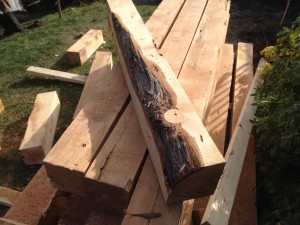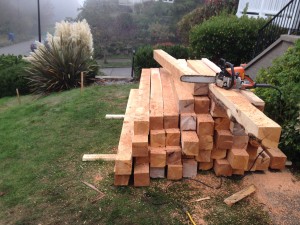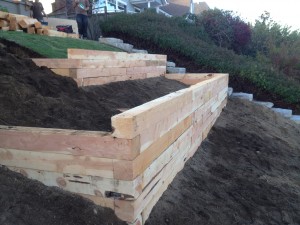15 Oct Juniper Landscape Timbers: a project
I’ve used Juniper 6×6 timbers before, so I know what to expect as far as twistyness and knottiness from them. However I got a nice batch of them from my local Dunn Lumber and am very satisfied with how the retaining wall project is turning out. We’ve been able to assemble the walls by installing the cleanest side out. I bought a whole bunk of them and they were bound with steel bands and stored inside, so at least for now most of them are straight-ish. Most of them have bark on them, all of them are riddled with knots.
The aroma of the cut Juniper lumber is appealing. I have developed an allergy to Western Red Cedar after having worked with it for my entire career, to the point where I need to wear a respirator when I cut it or suffer asthma-like breathing difficulties for days after cutting it. So far this Juniper treats me OK. I imagine it will ultimately have the same deleterious effect on my respiration as I cut more of it over the years. I love the smell of cedar sawdust still. I guess its the tannins in the lumber that make it so rot resistant that effect me. Juniper has a superior rot resistance, so ultimately it’s gonna get my neck!
This Juniper is farmed from Eastern Oregon. It’s got sustainability credentials, although I looked up some resources on the web and the details of which are squishy. Apparently using lumber from these trees is a newish idea, so there happens to be lots of them around and they grow in arid climates. The price has about doubled from the time I first used it three years ago, but it’s still affordable considering it’s doing the job cedar would do for those of us who don’t use chemical-soaked pressure treated lumber in our organic landscape projects. I always cringe when I see people making vegetable beds out of arsenic-laden, chromium and copper preserved wood. Yuk.
We generally use a type of lag bolt to fasten the timbers together, but this lumber likes to snap the bolts thanks to the amount of dense knots in the wood so we used a ceramic -coated screw. Those puppies are $2 each. We drove them with our 1/2″ drive electric impact wrench, which got a workout of it’s life. Juniper is dense wood. Adding to the fun was the pockets of rock within the lumber that the chainsaw found a few times. If you are at all familiar with the business end of a chainsaw, you know that with one rock strike, it’s goodbye sharp chain.
Well, in spite of all my gripes I’m psyched at how the project is turning out. I’ll try to make a blog post about this project when it’s finished, it should be a good “before and after” pictorial essay. Thanks for reading.




Michael Koirs
Posted at 06:28h, 31 JanuaryWe have a very similar front yard here in Asheville. Although we can’t get that type of lumber here, do you think using white pine timbers would be a mistake? We also are averse to using chemical treated lumber in our landscape.
Andrew Charlton
Posted at 21:32h, 14 JanuaryI’m also a Landscape Contractor. I’ve seen this lumber in a wholesale catalog and was wondering what was an appropriate use for it. Well, you’ve answered that for me. I’m glad to see another contractor who is concerned by the potential toxins leeching into garden beds by treated lumber. Your project will outlast your career, as we’ll as that of several generations of your family business.
Cheers, mate.
Smalt
Posted at 22:18h, 12 MayI would have used Teak logs to build that, but then again I’m filthy rich.
Wesley Dennett
Posted at 07:13h, 13 MayNicely done. I enlisted my neighbor and uncle to help me build a similar wall, but we used those Cedar toned round lumber from Lowes and after only 3three years, it’s already rotten. I wish we did more research so I could of used this type of Lumber.